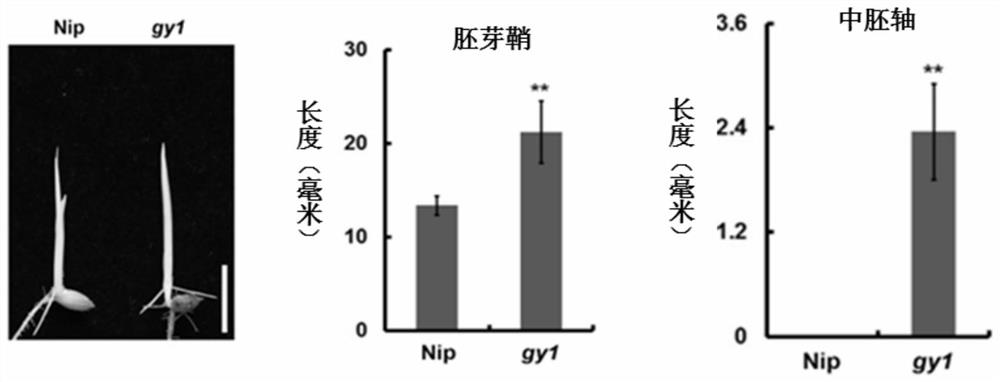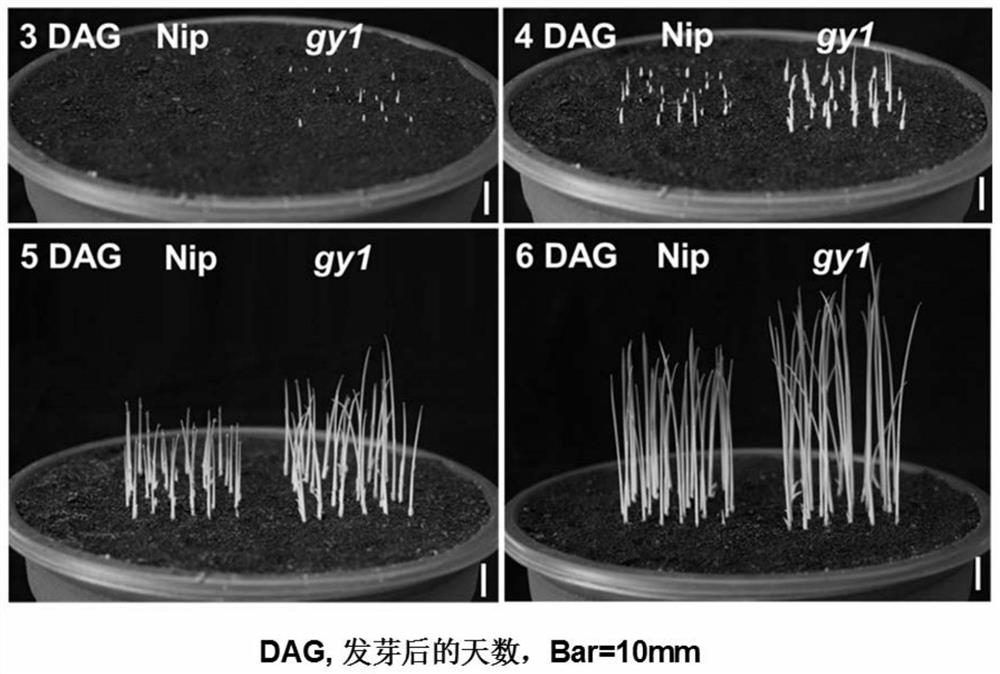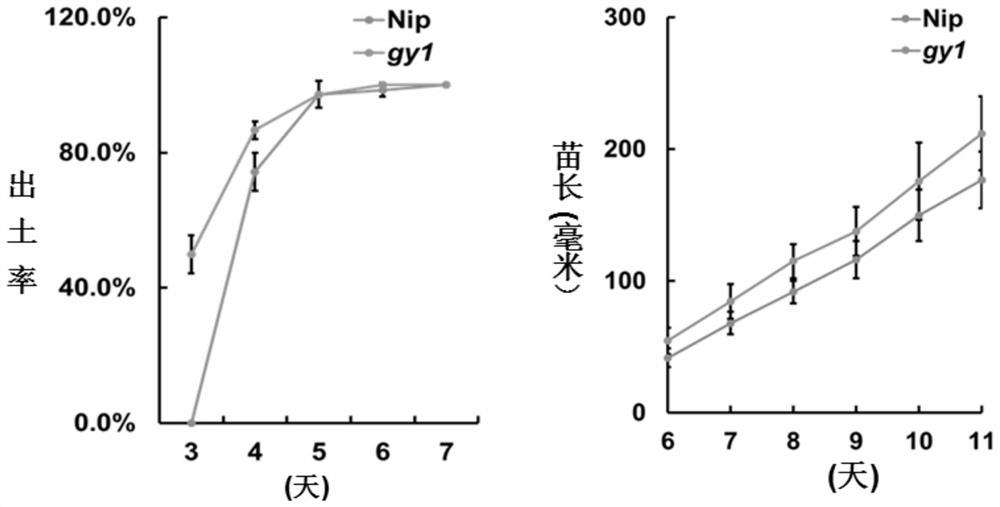Application of rice osgy1376t mutant material in breeding direct seeding varieties with high seedling emergence rate
A technology of rice and varieties, applied in the direction of application, hydrolase, determination/inspection of microorganisms, etc.
- Summary
- Abstract
- Description
- Claims
- Application Information
AI Technical Summary
Problems solved by technology
Method used
Image
Examples
Embodiment 1
[0049]Example 1. Obtaining of gy1 mutant and its phenotype analysis and identification of mutant gene sequence
[0050] 1. Discovery and phenotypic analysis of gy1 mutants
[0051] 1. Discovery of gy1 mutants
[0052] In the process of screening rice ethylene response-deficient mutants, the present invention found a mutant etiolated seedling derived from Nipponbare, whose coleoptile was longer than its control Nipponbare (Oryza sativa L.cv.Nipponbare, Nip), and had hydroponic conditions The mesocotyl structure was difficult to be observed in the yellow seedlings of Nipponbare, and the mutant was named gy1.
[0053] 2. Detection of coleoptile and mesocotyl length under hydroponic conditions
[0054] Under hydroponic conditions, both the coleoptile and mesocotyl of gy1 were significantly longer than those of the control Nipponbare (Nip). The coleoptile length of gy1 was about 21 mm, and that of the control Nipponbare was about 13 mm. It was difficult for Nipponbare to detect ...
Embodiment 2
[0072] Example 2, OsGY1 gene SNP site G376T and OsGY1 376T Gene acquisition
[0073] Through the screening of 52 varieties, it was found that the rice variety Casalas also has the characteristic of long mesocotyl. By detecting the coleoptile and mesocotyl lengths of rice varieties Kasaras and gy1 mutants, it was found that the coleoptile lengths of the gy1 mutant and Kasaras were about 1.6 and 6.0 mm, and the mesocotyl lengths were 19.5 mm, respectively. and 24.0 mm ( Figure 5 ). Both the coleoptile and mesocotyl of the rice variety Kasaras (Kas) were longer than those of the gy1 mutant.
[0074] Further sequencing of the Casalas OsGY1 gene showed that the 376th nucleotide of the Casalas OsGY1 gene was mutated from G to T, resulting in a mutation of the 126th amino acid of the OsGY1 protein encoded by it from glycine to cysteine (R126C )( Figure 6 ), the site (the 376th nucleotide of the OsGY1 gene) was named G376T. The mutated OsGY1 gene sequence is shown in sequenc...
Embodiment 3
[0075] Example 3, Correlation analysis of OsGY1 gene SNP site G376T and rice mesocotyl length
[0076] 1. OsGY1 genotype detection
[0077] After the 376th nucleotide of OsGY1 gene was mutated from G to T in Kasaras, the length of the coleoptile and mesocotyl was elongated. Correlation. Meta-analysis was performed on the OsGY1 gene SNP site G376T in the public resequencing data of 3000 rice resources with diverse representatives, and the genotype (TT genotype, GG genotype or GT genotype) of each rice resource was obtained.
[0078] Compared with the OsGY1 gene sequence of wild-type rice Nipponbare, it was found that 141 rice resources (including Kasalath, Kas) from different countries and regions belonged to different rice subgroups among the 3000 rice resources. It is TT genotype, that is, the 376th nucleotide of OsGY1 gene is mutated from G to T.
[0079] 2. Correlation analysis between genotype of OsGY1 gene SNP site G376T and mesocotyl phenotype
[0080] On the basis o...
PUM
| Property | Measurement | Unit |
|---|---|---|
| length | aaaaa | aaaaa |
| length | aaaaa | aaaaa |
Abstract
Description
Claims
Application Information
 Login to View More
Login to View More - R&D
- Intellectual Property
- Life Sciences
- Materials
- Tech Scout
- Unparalleled Data Quality
- Higher Quality Content
- 60% Fewer Hallucinations
Browse by: Latest US Patents, China's latest patents, Technical Efficacy Thesaurus, Application Domain, Technology Topic, Popular Technical Reports.
© 2025 PatSnap. All rights reserved.Legal|Privacy policy|Modern Slavery Act Transparency Statement|Sitemap|About US| Contact US: help@patsnap.com



